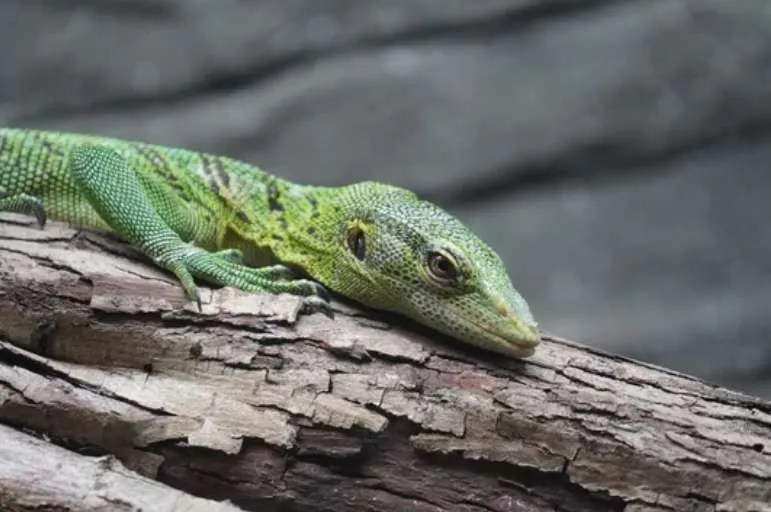The emerald tree monitor (Varanus prasinus) is a strikingly beautiful lizard native to the tropical rainforests of Indonesia, Papua New Guinea, and the Torres Strait Islands near Australia. Known for its vibrant green coloration and remarkable agility, this arboreal reptile captivates scientists, reptile enthusiasts, and zoo visitors alike. Its long, prehensile tail and sharp claws make it a master of tree-dwelling life, and its social nature sets it apart from many other monitor species. Let’s explore the fascinating world of the emerald tree monitor and uncover what makes this species so unique.

Table of Contents
Taxonomy and Classification
The emerald tree monitor belongs to the family Varanidae and the genus Varanus. Its scientific name, Varanus prasinus, derives from the Latin word “prasinus,” meaning green, perfectly describing its striking appearance. This species is part of the subgenus Euprepiosaurus, which includes other tree-dwelling monitors such as:
- Varanus beccarii
- Varanus boehmei
- Varanus bogerti
- Varanus keithhornei
- Varanus kordensis
- Varanus macraei
- Varanus reisingeri
- Varanus telenesetes
10 Reasons Why Your Leopard Gecko’s Mouth Is Open
Physical Characteristics
One of the most distinguishing features of the emerald tree monitor is its sleek, slender body, which can reach up to three feet in length. Its tail, which is nearly twice the length of its body, is fully prehensile, making it the only monitor lizard with this adaptation. This unique feature allows it to grasp branches firmly, aiding in its arboreal lifestyle.
Its vivid green scales, often adorned with small blue or black speckles, provide excellent camouflage among the dense foliage of the rainforest. Its limbs are equipped with sharp claws that enable it to climb effortlessly, and its long tongue helps it detect scents in its environment.
Behavior and Social Structure
Unlike many lizards that lead solitary lives, emerald tree monitors exhibit social behavior. They often live in small groups, typically consisting of a dominant male, several females, and younger males. This social structure is rare among reptiles and adds to the intrigue surrounding this species.
These monitors are also highly intelligent. They have been observed displaying problem-solving abilities when hunting, often using their forelimbs to manipulate prey. Their keen eyesight and agile movements make them formidable predators within their habitat.
Habitat and Distribution
The emerald tree monitor thrives in humid, tropical environments, primarily in:
- Rainforests – Their dense canopies provide ample cover and
food sources. - Mangrove Swamps – These wetlands offer both shelter and access to a variety of prey.
- Cocoa and Palm Plantations – These cultivated areas sometimes serve as alternative habitats.
High humidity levels are crucial for this species, as they obtain much of their water from the surrounding air. Their green coloration allows them to blend seamlessly into leafy environments, offering protection from potential predators.
Diet and Hunting Strategies
As carnivores, emerald tree monitors primarily consume:
- Insects such as grasshoppers, termites, and katydids
- Small vertebrates like geckos and birds
- Occasionally, small rodents and crabs
In captivity, they are often fed mice, crickets, and cockroaches. Their hunting techniques involve keen observation, precise strikes, and even using their forelimbs to pin down or manipulate prey.
Reproduction and Life Cycle
Emerald tree monitors can reproduce up to three times a year. After mating, the female incubates her eggs for about 165 days. A unique aspect of their reproductive behavior is their use of termite mounds as nesting sites. These mounds provide stable temperature and humidity, ideal for egg incubation.
A typical clutch consists of three to seven eggs. Once hatched, the young monitors immediately feed on termites and termite eggs. Juveniles grow rapidly, quadrupling in size within their first three months of life. Sexual maturity is reached at around two years of age.
Predators and Threats
While adult emerald tree monitors are apex predators within their ecosystem, their eggs and hatchlings face threats from:
- Snakes – Opportunistic predators that raid nests.
- Birds of Prey – Raptors that hunt small reptiles.
Human-related threats include:
- Habitat Destruction – Deforestation for agriculture and urbanization reduces their natural habitat.
- Poaching – Due to their striking appearance, they are sometimes captured for the illegal pet trade.
Conservation Status
The International Union for Conservation of Nature (IUCN) lists the emerald tree monitor as Least Concern, indicating that the species does not currently face imminent extinction threats. However, ongoing habitat destruction and illegal wildlife trade could pose future risks.
Also read about: 10 Reasons Why Your Snake Is Not Eating And How To Help

Emerald Tree Monitors in Captivity
Due to their beauty and fascinating behavior, emerald tree monitors are popular attractions in many zoos and aquariums worldwide. Institutions that house these lizards include:
- Smithsonian Institution
- Bristol Zoo
- Tennessee Aquarium
- Lehigh Valley Zoo
- Cincinnati Zoo & Botanical Garden
While some reptile enthusiasts keep emerald tree monitors as pets, they require expert-level care. Maintaining the appropriate humidity, temperature, and enclosure size is crucial. Additionally, they are not fond of handling, making them more suitable for observation rather than direct interaction.
The emerald tree monitor is a remarkable reptile that showcases the beauty and complexity of rainforest ecosystems. Its intelligence, social behavior, and striking appearance make it one of the most fascinating members of the monitor lizard family. While its population remains stable, continued conservation efforts are essential to protect its natural habitat and prevent illegal poaching. Whether seen in the wild or in a zoo, this elegant lizard remains an extraordinary example of nature’s adaptability and resilience.
- Enchi Ball Python: A Unique and Stunning Morph of Python regius - March 27, 2025
- Emerald Tree Monitor: The Enigmatic Green Guardian of the Rainforest - March 26, 2025
- The Egyptian Cobra (Naja haje): A Fascinating Serpent - March 25, 2025
